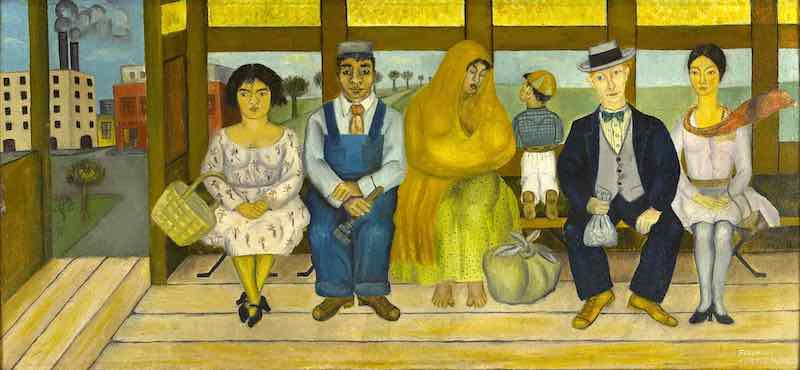
El 17 de septiembre de 1925, Frida viajaba en un camión que iba hacia Coyoacán, acompañada por su entonces novio Alejandro Gómez Arias; regresaban de la preparatoria.
Ella recordaba el accidente de la siguiente forma: «A poco de subir al camión, empezó el choque. Antes habíamos tomado otro camión, pero a mí se me perdió una sombrillita y nos bajamos a buscarla. Fue así que subimos a aquel camión que me destrozó. El accidente ocurrió en una esquina frente al mercado de San Lucas, exactamente enfrente. El tranvía marchaba con lentitud, pero nuestro camionero era un joven muy nervioso. El tranvía, al dar la vuelta, arrastró al camión contra la pared. Yo era una muchachita inteligente, pero poco práctica, pese a libertad que había conquistado. Quizá por eso no medí la situación ni intuí la clase de heridas que tenía. En lo primero que pensé fue en un balero de bonitos colores que compré ese día y que llevaba conmigo. Intenté buscarlo, creyendo que todo aquello no tendría mayores consecuencias. Mentiras que uno se da cuenta del choque; mentiras que se llora. En mí no hubo lágrimas. El choque nos botó hacia delante y a mí el pasamanos me atravesó como la espada a un toro. Un hombre me vio con una tremenda hemorragia, me cargó y me puso en una mesa de billar hasta que me recogió la Cruz Roja.»
Frida nunca se atrevió a recrear en alguna de sus obras el accidente en forma; realizó algunos dibujos y esta pintura titulada El camión, en la que se puede observar a la gente que viajaba en este tipo de transporte. Podían coincidir una mujer indígena descalza, un obrero, un burgués y una mujer joven, que bien podría ser la misma Frida. Un niño mira por la ventana un paisaje lleno de tranquilidad, en el cual destaca un comercio llamado La risa, detalle significativo del humor negro de Frida, quien representó el momento previo al accidente.
On 17 September 1925 Frida was riding a bus to Coyoacán, accompanied by her boyfriend Alejandro Gómez Arias. They were returning home from school.
Frida remembered the accident as follows: «A little while after boarding the bus, the collision began. Before that we had taken another bus, but since I had lost a little parasol, we got off to look for it. That was how we got on the bus that broke me. The accident took place on a corner in front of the San Lucas market, exactly in front. The streetcar went slowly, but our bus driver was a very nervous young man. When the trolley car went around the corner the bus was pushed against the wall.
I was an intelligent young girl, but impractical, in spite of all the freedom I had won. Perhaps for this reason, I did not assess the situation nor did I guess the kind of wounds I had. The first thing I thought of was a balero [a Mexican toy] with pretty colors, which I had bought that day and carrying with me. I tried to look for it, thinking that what had happened would not have major consequences.
It is a lie that one is aware of the crash, a lie that one cries. There were no tears in me. The crash bounced us forward and a handrail went right through me, the way a sword pierces a bull. A man saw me having a tremendous hemorrhage. He carried me and put me on a billiard table until the Red Cross came for me.»
Frida never dared to depict the accident directly in a work, though she did make some drawings and this painting entitled The Bus, which shows a group of passengers riding the same means of transport. The painting shows a barefoot indigenous woman, a worker, a middle-class gentleman, and a young woman who might well be Frida herself. A child is looking out the window on a landscape full of calm. A shop named La Risa (The Laughter) stands out. This detail is characteristic of Frida Kahlo’s black humor, who in this way represented the moment just before the accident.
Material documental propiedad del Museo Dolores Olmedo, realizado por Josefina García.